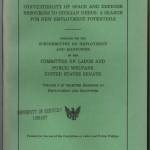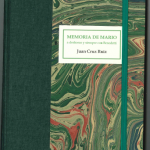Modeling history. (OCLC #988928518)
Sometimes I receive oddly-shaped materials for cataloging, such as this book with uncut pages (on the bottom) that are intended to stay uncut. Only the outsides are numbered, and the resulting “pocket” in many cases holds loose photos/cards. I was able to find copy (thank you EYM), so didn’t have to wonder about this one very long.
The physical description is done as:
300 __ ǂa 63 pages : ǂb illustrations (some color) ; ǂc 29 cm
+ ǂe 16 cards.
This is correct, as 63 is the last numbered page in the volume. While it is thicker than the average 63-page book, using this number is not “misleading” in a RDA 3.4.5.5 sense; it correctly describes the number of pages with content, and similar standards are followed for traditional Japanese books with double leaves.
They did include a concise note to explain the weirdness:
500 __ ǂa Pages uncut at bottom, with cards inserted between
pages in photography section.





